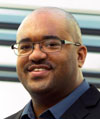|
Lectures |
| Week
1 |
Week
2 |
Week
3 |
Week
4 |
Week
5 |
Week
6 |
Week
7 |
Week
8 |
Week
9 |
Week
10 |
|
|
|
|
|
|
|
|
|
|
|
Thursday, February
9th
|

|
Assistive
Robotics
Monroe Kennedy III,
PhD
Assistant Professor of Mechanical Engineering
and, by courtesy, of Computer Science - Stanford University |
Abstract: The development of
Assistive Technology benefits from the contributions of many areas of study.
Engineering of physical devices plays a crucial role in meeting the needs of
the user and improving the human experience. There are many user needs however,
that would greatly benefit from systems capable of not only performing
passively, but also from devices that can take action to directly help the
user. The question becomes "How can an assistive device capable of taking
action, determine the best action to take, in order to help the user at a given
moment?". This question leads to the field of Robotics, which is the
development of 'thinking' machines. While the term 'thinking' here is used very
broadly, it can be simplified to the ability to observe a scenario
(perception), 'think' or plan about what action to take (this could range from
a simple feedback control principle to a machine learning model), then perform
some action on the world to change the scenario in some way. Assistive Robotics
is the field of study of applying all the advancements of robotics to assistive
technology solutions that would benefit from 'thinking' devices. In this talk,
I will highlight basic principles of 'thinking' machines and discuss the
application of these principles to assistive technology with a primary focus on
work performed in the Stanford Assistive Robotics and Manipulation Laboratory
(ARMLab).
Biosketch: Monroe Kennedy
III received his PhD in Mechanical Engineering and Applied Mechanics, and a
Masters in Robotics from the University of Pennsylvania where he was a
recipient of both the NSF and GEM graduate research fellowships. His area of
expertise is in robotics, specifically the development of theoretical and
experimental approaches to perform control and estimation for robotic systems,
in particular, robotic manipulation and human-robot collaborative tasks. He
applies expertise in dynamical systems analysis, control theory (classical,
non-linear, and robust control), state estimation and prediction, motion
planning, vision for robotic autonomy, and machine learning.
Monroe is the director of the
Assistive Robotics and Manipulation Lab (ARMLab) whose broad research objective is
to develop technology that improves everyday life by anticipating and acting on
the needs of human counterparts. ARMLab specializes in developing intelligent
robotic systems that can perceive and model environments, humans and tasks and
leverage these models to predict system processes and understand their
assistive role. ARMLab focuses heavily on both the analytical and experimental
components of assistive technology design. While the application area domain is
autonomous assistive technology, the primary focus is robotic assistants
(mobile manipulators and humanoids) with the goal of deployment for service
tasks that may be highly dynamic and require dexterity, situational awareness,
and human-robot collaboration.
- Contact
information:
- monroek -at-
stanford.edu
- Lecture Material:
- Pre-lecture slides - 1.16 Mb pdf file
- 10 Commandments of Making -
(10:03)
- Slides - 44.4 Mb pdf file
- Links:
- Stanford
Profile
|